I was in charge of a guide for "Ningyocho-Higashinihombashi" in the training of a certain guide club, and as a guide for the "Tsukiji" and "Ningyocho" districts, I investigated the interest of Asakusa Mido.
Tsukiji Nishi Honganji Temple is the reconstruction of Nishi Honganji Temple in Asakusa Hamacho, which was destroyed by the great fire of the Meiryaku era. Asakusa Mido, the original Nishi Honganji Temple, was founded in Asakusa Hamacho in March 1621. The location is the back of Machiya, 2-chome, Yokoyamacho. In Kanei 2 (1625), the Shogunate officially recognized as a separate hospital and became "Nishi Honganji Temple". It is also known as "Edo Seaside Gobo" or "Hamacho Gobo".
If you refer to the Edosho map of Bushu Toyoshima-gun, you can see Asakusa Gobo on the east side, just north of Hamacho moat behind Motoyoshihara. (Refer to the cut-out picture below.)
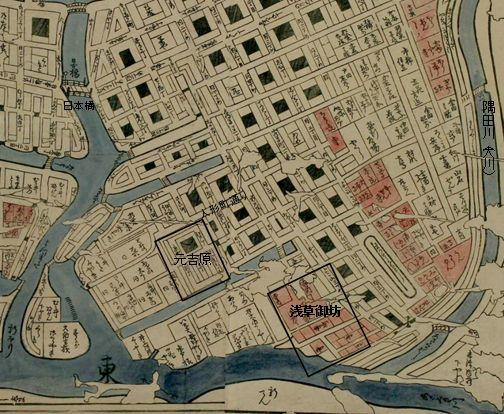
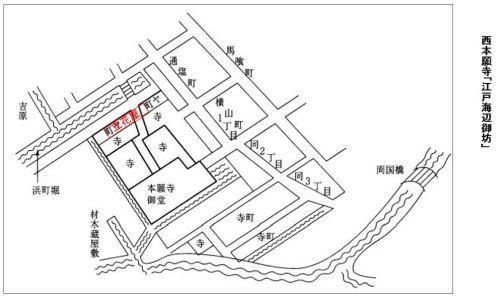
There was a small townhouse on the moat side of Hamacho, branch temple, main hall. It is said that "Tachibana" was sold here, and there is a theory that it was later named "Tachibana-cho".
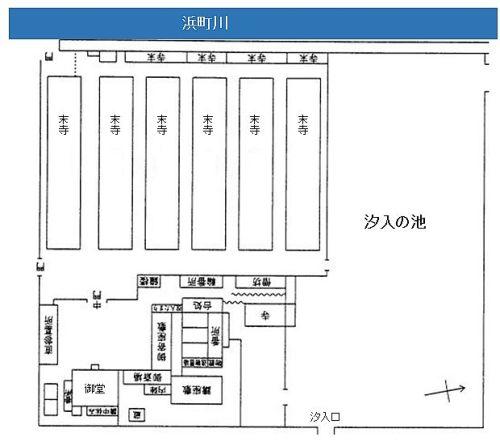 There are 57 branch temples on the premises, Mido's size was 12 spaces (width) X8 spaces (depth), and the direct burial ground on the left side of Mido was 58 tsubo. It is said that the size of Nishi Honganji Temple would have been 20,000 to 30,000 tsubo, given by Matsudaira Echizen Mamoru in the Meiryaku era.
There are 57 branch temples on the premises, Mido's size was 12 spaces (width) X8 spaces (depth), and the direct burial ground on the left side of Mido was 58 tsubo. It is said that the size of Nishi Honganji Temple would have been 20,000 to 30,000 tsubo, given by Matsudaira Echizen Mamoru in the Meiryaku era.
The part facing Hamacho moat will be Tachibana-cho later. Tachibana-cho is said to be "Higashibashi 3-chome" on the current map. The area surrounded by the red frame is Higashi Nihonbashi 3-chome.
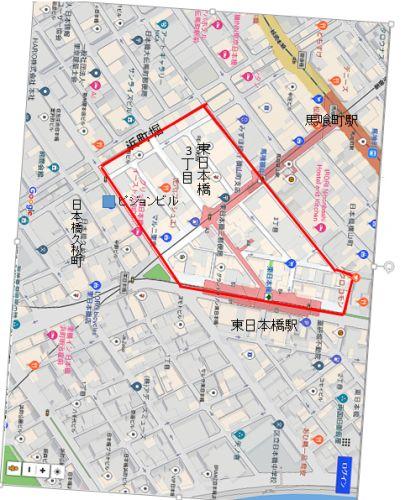
After the great fire of the Meiryaku era, Higashi Honganji Temple moved to Asakusa Sanjusangen-do Temple and Nishi Honganji Temple moved to Hatchobori Tsukiji Temple "Umiai". After the relocation, Nishi Honganji Temple follows a strange fate.
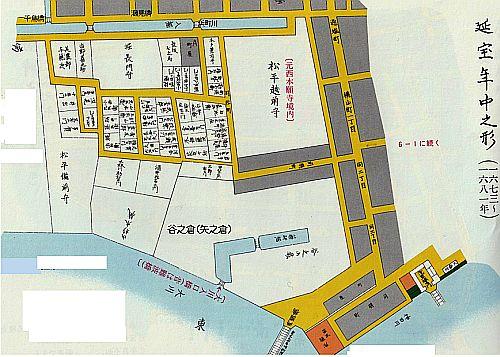
After the relocation of the temple due to the great fire of the Meiryaku era, Terachi was taken up, and the traces of Nishi Honganji Temple and Asakusa Mido were given to Matsudaira Echizen Mamoru of the Fukui Domain, which has strong connection with Junyo, on May 14 of the same year. You. There were 13,000 tsubo. With this in mind, the surrounding area gradually changed its appearance, and on the east side of Matsudaira Echizen Moriyashiki, the land of the Shogunate officials and lent it to townspeople, became a town area, `` Dobo-cho '' (Doho-cho) was born, and the moat drawn behind Asakusa Mido became Yagenbori, and the Yonezo of this area was set up in the Yonezo area, where the salary of the whole area. In the south of the mansion, there is a small town, Muramatsucho, and further south is a samurai residence. Let's refer to "Enpo era Nakanogata" (upper figure) in the Chuo-ku history book. At the location of Nishi Honganji Temple, the ambiguous expression "Yokoyamacho 2-chome South Machiya Ura" is generally made, but if you look at this material, you can nodd it.
Reference:
1) Chuo-ku History Chart
2) Takashi Shiraishi: "Nihonbashi Tachibana-cho Commercial History Memorandum of Understanding - Wholesalers and Town-"
(Mita Business Research, Vol. 41, No. 6, February 1999)
3) Tokyo Famous Places

